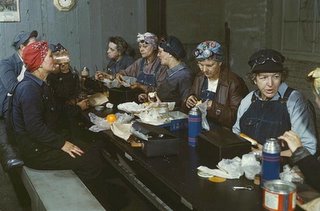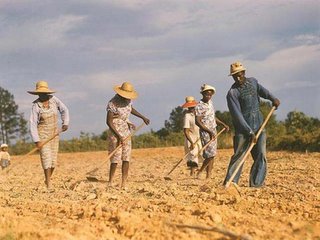Like Yesterday
 BAG NEWS NOTES
BAG NEWS NOTES
The Library of Congress has recently launched an exhibition of little known color photographs produced by the government between 1939 and 1943. Taken for the Farm Security Administration/Office of War Information, they chronicle scenes from the end of the Depression through the ramp up to WW II. For people old enough to have lived through these years, these images might be nostalgic. For those of us who have come to know this era through an austere monochrome, however, the effect can be a little strange.
Because The BAG's interest is as much political as visual, I have a number of questions about this collection, and these examples in particular. The first image shows African Americans chopping cotton in Georgia in 1941, and the second depicts women railway workers in Iowa in 1943.
Doesn't the presence of color tempt us to read these pictures in more "contemporary" terms? If so, aren't these images that much more difficult to relate to considering the intermediary impact of the civil rights and women's rights movements?
Given the way many Americans have ceded history to Hollywood, is it hard to get past the idea (especially with the saturated colors of the kodachrome) that these are just movie stills with actors in period dress?
It is well known that the FSA images taken by the likes of Dorothea Lange, Russell Lee and Walker Evans were created for propaganda purposes. The shots were intended to educate the country about farming problems, promote The New Deal, emphasize the ability of American's to overcome adversity, and encourage the war effort. Given that these images were widely distributed in the media, is the tendency of the government to frame a story line really that much different today than it was sixty years ago?
Bound for Glory: America in Color exhibition website here.
Link Here




0 Comments:
Post a Comment
<< Home